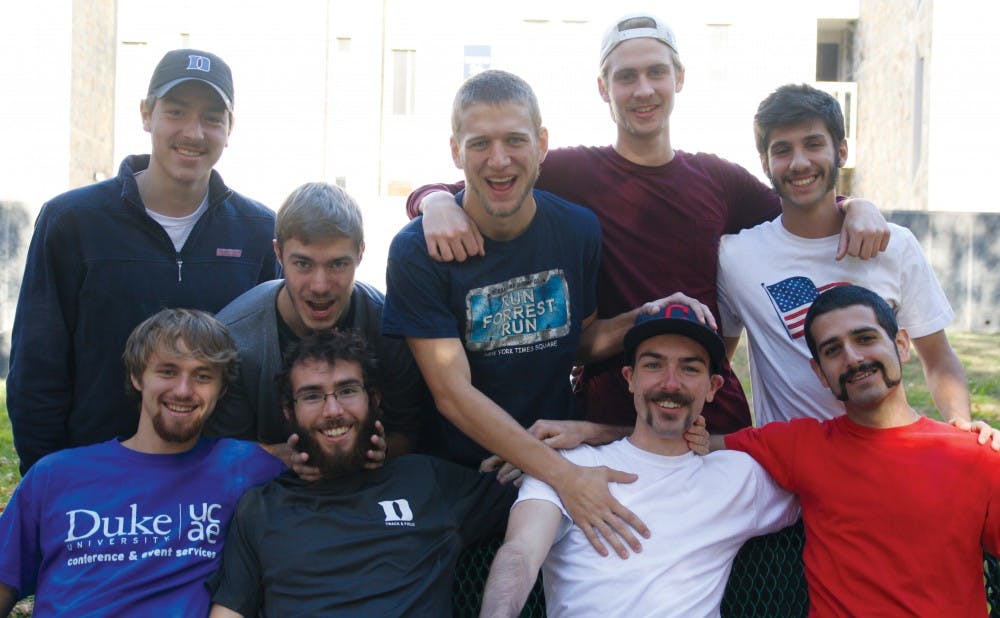With the NCAA Southeast Regional Championships looming this Friday and a berth for the NCAA Championships on the line, Duke has turned to a training technique that every runner knows well: growing mustaches.
Wait—what?

The phenomenon originated with the running website Flotrack.org, which has run a “Stachies for Nashies” photo competition in recent years. The setup is simple—run fast enough to qualify for the national cross-country meet ("Nashies"), grow a mustache, and document the lip lettuce to enter the online contest.
But while other teams halfheartedly grow top-shelf ticklers, the Blue Devils channel their inner Tom Selleck and use strategic timing to gain a leg up on their rivals.
“[Flotrack] tries to get us to do it from October through Nationals, which is usually Thanksgiving weekend,” Moverman said. “But my sophomore year we started taking it to the extreme. We started the first week of camp, a month and a half before all the other teams were starting.”
Moverman credits the captains of the team that year—Ryan McDermott and Bo Waggoner—with firmly cementing the mustache tradition at Duke. McDermott, in particular, is still a name that resounds through the annals of Duke’s rich mustache history.
“[McDermott] had the original Fu Manchu,” Moverman said. “The guys still talk about it as the original sweet mustache.”
Although McDermott has since graduated, his whisker wizardry has been replaced by that of Moverman and junior Shaun Thompson, who is widely regarded as the most talented on the team—at growing facial hair, that is.
“In high school, I was lucky enough to be endowed with the ability to grow a beard,” Thompson said, twirling his scruffy lumberjack beard. “[And as you mature], you improve in your ability to run and your ability to grow facial hair.”
It doesn’t hurt Thompson that he’s joined a hair-heavy locker room like Duke’s. Still, he maintains that his success is a case of nature over nurture.
“The Thompsons are a strong line of beards,” Thompson said. “It’s been passed on for many generations, and I have a lot to live up to with the strength of my beard.”

The key characteristics of good, strong facial hair were universally agreed upon within the team. A powerful look needs to be full—covering the desired area consistently, not simply in patches. It must be long, and unfortunately for blondes, darkness was also heavily regarded.
“Out of the three characteristics, Shaun wins in all three,” Moverman said. “He had an unfair advantage starting in the mid-summer, but that’s a lot of commitment.”
Thompson claims that his head start was not selfish but rather necessary to uphold Duke’s reputation as a forerunner in the facial hair field.
“Some of the kids on the team had to shave for interviews,” Thompson said. “Really, I was trying to make up for their slack and their inability to commit to the full beard, so I had to [start] early.”
By growing the mustaches out over the whole cross country season, the runners make sacrifices both socially and professionally. Seniors burdened with interviews for jobs and graduate schools are given leeway, but otherwise, the Blue Devils typically put their egos aside for the sake of tradition and team-building.
“I don’t know how kindly the women at Duke look at it, but we enjoy it, and it definitely brings us closer,” Moverman said.

“You won’t get a girl if it looks like [Thompson's],” said Ashley Brasovan, who flaunts neither beard nor mustache. “At this point, I’m not going to make a big deal about it. [I] just let him do his thing, and it’ll be gone when Nationals is over.”
Battling the ‘stache stigma is an ongoing effort. In Thompson’s freshman year, an elder teammate shaved all of his facial hair off prematurely to “try to make friends.”
Even Thompson struggles to balance his looks and his other responsibilities.
“I work in a middle school tutoring, and the stigma with the mustaches… I don’t think it’d go over too well if I just had the ‘stache for a long time," Thompson said.
Besides its connotations, the style is also dated, having peaked in the 1970s and ‘80s. This period boasts some of history’s premier mustachioed men—Selleck, Burt Reynolds, Carl Weathers, Rollie Fingers, etc. Perhaps the most famous “modern” mustaches are those of characters: Will Ferrell’s Ron Burgundy in Anchorman and Nick Offerman’s Ron Swanson in Parks and Recreation.
Despite the noble attempts of the team to bring the look back into style, it’s been a rocky ride. For outsiders, seeing so many mustaches today is jarring, Moverman said.
Still, the ‘stache surprise can sometimes provide its hosts with an upper hand against an unsuspecting witness. When Moverman interviewed for medical school, he found himself justifying the look to a begrudging school official.
“The first thing she said was, ‘Did you have facial hair when you sent in your picture for the application?’” he said. “I sort of explained the whole situation, and I think she found it funny. It makes you stand out a little more, and people remember you more.”
Senior Christian Britto, going through his own set of interviews for jobs, has been hesitant to commit to the bold mustache and risk unemployment but hasn’t cut his hair in over a year. As a result, he’s flaunting an even more outrageous look: the mullet.

Moverman and Thompson have been top runners for Duke this season along with senior Brian Atkinson, who Moverman deemed “Mr. Consistent” for his performances in both the running and mustache departments. Together, the three—despite Atkinson’s disadvantage as a blonde—form as strong a mustache trio as any.
When asked whether it was a coincidence that the top runners also had stellar ‘staches, Moverman was unequivocal.
“When you start running hard, the hair starts growing,” he said. “I don’t think you can be a true champion without having a great mustache.”
Get The Chronicle straight to your inbox
Signup for our weekly newsletter. Cancel at any time.

